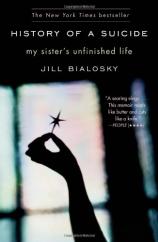History of a Suicide: My Sister's Unfinished Life
Review
History of a Suicide: My Sister's Unfinished Life
Each year in the United States, some 30,000 people commit suicide and another 500,000 make the attempt. Jill Bialosky's intense, searching re-examination of her sister's suicide at age 21 tells the story of one such tragedy. But Bialosky's motivation and focus aren't purely personal. "Suicide should never happen to anyone," she writes. "I want you to know as much as I know. That is the reason I am writing this book."
In the early morning hours of April 16, 1990, Bialosky's sister Kim entered the garage of the Cleveland home where she lived with their mother, turned on the ignition of her mother's car, and fell asleep. By the time a young neighbor found her body, she had been dead for hours. Drawing on a rich store of memory and offering episodic glimpses illuminated by excerpts from Kim's journal and prosaic lists like the contents of her wallet at the time she died or an inventory of her room ("the entirety of her estate"), Bialosky retraces her sister's brief, troubled life. Born 10 years after the author, Kim was the child of her mother's second marriage (her first husband, Bialosky's father, died suddenly in his 20s), to a handsome, sociable and self-absorbed man whose abandonment of the family when Kim was three seems to have been the seminal event that set her life on its disastrous course.
What's most troubling about Kim's story as Bialosky unearths it --- "an archaeologist uncovering the relics of the past, searching for truth from fragments" --- is that there's no sense her destiny was foreordained. Her experimentation with drugs and alcohol, her struggles in school, even the painful end of her relationship with a drug dealer boyfriend whose own life culminated in suicide several years later, were episodes not markedly different from those experienced by countless young women. And yet, somehow, some "all-consuming psychic pain" at the core of her being eventually overwhelmed her for reasons she almost certainly never fully understood.
Without sacrificing the intensely personal quality of her narrative, Bialosky explores questions about a possible genetic predisposition to suicide, visits a bereavement group and, near the end of the book, describes her encounter with Dr. Edwin Shneidman, an elderly suicide expert who pioneered the "psychological autopsy" in an effort to probe the minds and motivation of suicide victims. One can't escape a sense of frustration that even with this large and growing body of knowledge there's no way to prevent every instance of self-annihilation.
There's a parallel story here, and that's the one of Bialosky's own journey across the painful decades after her sister's suicide, as she struggled to understand what drove Kim to the act and wondered, like any survivor, whether, through some word or gesture, the outcome might have been different. Four months pregnant at the time of Kim's death, Bialosky loses that baby ("The trauma of losing my firstborn and the loss of Kim to suicide have forever become tangled like threads in a rope.") and then loses a second child late in another pregnancy. She and her husband finally adopt a newborn, and the observations of her son's life as he moves from childhood into his teenage years are shadowed by her sister's story.
Bialosky, an editor, poet and novelist (her novel, HOUSE UNDER SNOW, tells the story of young women growing up in a household not unlike the real one portrayed here), brings that literary sensibility to the telling of this story in quiet, unaffected prose. Snippets of Shakespeare (52 of whose characters die by their own hand, she points out), Sylvia Plath, T.S. Eliot, and especially Melville, whose MOBY-DICK, "a treatise on the abyss and the inchoate and terrible power of inner demons," serves as a pervasive metaphor for the mind of a suicide, offer insight, if not always comfort.
One can imagine Jill Bialosky paging through a family album, its photographs, even the smiling ones, now edged irretrievably in black: "I have to remind myself that I am allowed to be among the living even though one hand holds the hand of the dead. And it is with each word I write, transformed by memory, time, and experience, that I relentlessly try to stitch back together what we have lost as if to make a quilt from which to draw comfort." That it took her some 20 years to produce this memoir is a testament both to the difficulty of revisiting the trauma and her determination to tell that story with sensitivity and honesty. The greatest tribute one can pay to this book is to acknowledge that by the time Kim's heartbreaking life reaches its conclusion, we mourn her passing as if we knew her.
Reviewed by Harvey Freedenberg (mwn52@aol.com) on March 28, 2011
History of a Suicide: My Sister's Unfinished Life
- Publication Date: February 7, 2012
- Genres: Nonfiction
- Paperback: 272 pages
- Publisher: Washington Square Press
- ISBN-10: 1439101949
- ISBN-13: 9781439101940





